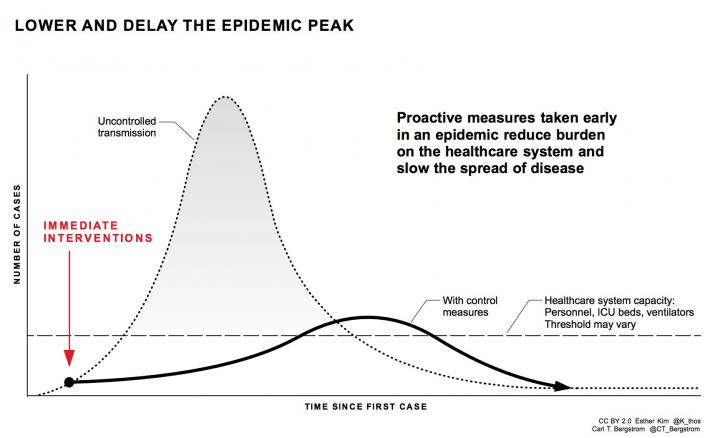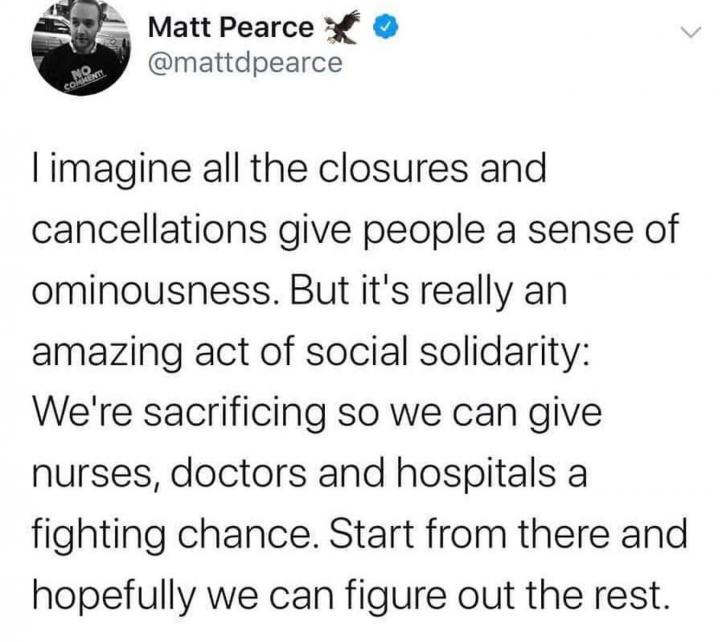Social Distancing? Quarantine? Isolation? Lockdown? With the COVID-19 cases growing, we’re learning more about these terms. What do they mean and when do they apply? As always, Peg helps dispel that confusion with calm, accurate facts, and realistic steps which you can take.
You may have read my first post about COVID-19—what it is, how it started, and how to prudently prepare.
Now COVID-19 has arrived in most communities, bringing us anxiety and confusion. Many schools, businesses, and places of worship have closed, many of us have found supermarket and pharmacy shelves empty of toilet paper and many foods, hand sanitizers, fever thermometers, and over-the-counter pain relievers.
COVID-19 Is Not Just Another Flu
In fact, it isn’t flu at all. It’s a new disease that recently jumped from animals to humans. We don’t have any natural immunity to it, a vaccine to prevent it, nor any drugs to treat or cure it. It’s many times deadlier than influenza.
If our health systems overflow, many people may not get even the supportive medical care they will need care to help them recover.
We’re reading and hearing many terms referring to government actions and human behaviors intended to slow down the spread of this highly contagious infection. Collectively, they help “flatten the curve” of unchecked growth in COVID-19 cases.
Flattening the curve may keep the disease from spreading so rapidly that it overwhelms the capacity of first-responders, healthcare professionals, and hospitals to meet the needs of caring for the very ill.
Flatten the Curve

Credit: Designer Esther Kim
Social Distancing, aka Physical Distancing
As the phrase suggests, social distancing (some public health advocates prefer “physical distancing”) means keeping one’s distance from others, even if you and they feel well.
In the case of COVID-19, infectious disease specialists suggest staying at least six feet from another person.
Social distancing applies to all apparently healthy people right now.
This means staying away from crowded places, even slightly crowded places: restaurants, markets, bars, sports events, theaters, concerts, book clubs, neighborhood get-togethers—even religious services, weddings, and funerals.
Two important facts:
- Emerging data suggest that people infected with COVID-19 are most contagious during the early days of the illness, when their symptoms are mild, perhaps even before they experience symptoms at all.
- Children seem less likely to suffer serious COVID-19 infections, but they are as likely as adults to become infected; an infected child can spread the disease to others.
That’s why many schools and businesses have closed and begun finding ways to study and work remotely. That’s also why maintaining a physical distance from others is important, even if there’s little sign of the virus in your community yet, and even if you all feel great. If you’re a grandparent caring for children, do everything you can to protect yourself.
Self-Quarantine
Self-quarantine is a public health term and an important tool for preventing the spread of illness to others.
This applies to both healthy and/or exposed-but-not-sick people practicing social/physical distancing—by staying home. This goes beyond public gatherings.
Health experts define COVID-19 quarantine to mean no play-dates for children, neighbor-to-neighbor visits, and especially, no face-to-face time with elders and disabled family members, even if everyone involved seems healthy. They suggest staying in touch with family, friends, and work colleagues by phone, text, email, and online video-conferencing apps such as Skype, FaceTime, and Zoom, for a few weeks.
The federal government has broad powers to prevent the spread of communicable disease into the U.S. or between states, which is why we’ve begun seeing a patchwork of travel bans. But it currently has no power to impose and enforce a broad quarantine like those ordered in China, Italy, France, Spain—sometimes called a lockdown. That could change.
On the other hand, most states and many local jurisdictions have laws/regulations allowing civil authorities to mandate and enforce quarantines within their borders. Because there are no national standards, it’s important to follow your local news and local health authorities, and to follow their instructions, for your own health and that of your fellow citizens.
Self-Isolation
Isolation is another public-health term that means keeping sick people separated from healthy people.
Infectious disease specialists say that people who have symptoms (e.g., sore throat, dry cough, fever, achiness, headache, difficulty breathing, sometimes mild nausea or diarrhea) whether or not they have a positive diagnosis of COVID19, should self-isolate at home, ideally in a separate room with a bathroom not shared by healthy household members.
Isolation also means not sharing towels, personal care items, eating utensils, plates/cups/drinking glasses. Sick people should wear masks and cough into tissues, disposing of them in garbage bags tucked into closed containers. Then they should carefully wash their hands.
If you’re sick and self-isolating at home, follow this guidance from the Centers for Disease Control and Prevention. Call your doctor for detailed instructions on caring for yourself in your particular circumstances.
If you become very sick, especially if you have trouble breathing, call for help immediately. Make sure to tell emergency responders that you have or may have COVID-19.
If you’re caring for a sick person in isolation, phone your doctor for detailed instructions on staying safe yourself. Follow them to the letter.
Worth Repeating: Recommendations for Daily Life
- Wash your hands, frequently and thoroughly. Soap and water are preferable to hand sanitizers (the virus is enclosed in a fat layer that’s broken up by soap molecules, disintegrating the virus).
- Disinfect commonly used surfaces frequently. Research shows invisible virus particles shed by a sick person can remain infective for days on hard surfaces.
- Practice not touching your face until you’ve washed your hands first.
- Disinfect common surfaces by saturating them with a 10 percent bleach solution (one part household bleach, nine parts water) or even by scrubbing with soap and water. If you do use bleach, make a fresh solution every day.
- Keep at least six feet from others, especially when you’re out and about.
- Don’t shake hands or elbow-bump. Nod, wave, or press your hands together in the prayerful gesture known as namaste.
It’s all hard to hear and even harder to do
Yes. What’s more, experts tell us to expect the COVID-19 pandemic to become much worse in the coming weeks and months.
Let’s come together. Let’s comfort each other. While we need to maintain physical distance from each other to slow the spread of COVID-19 infections, we also must find ways to maintain and increase our social connections to one another: online, on social media, on the phone, across the fence in backyards. We need to share our strengths and fears, our funny stories, our family projects, and other tips for having fun while hunkering down.
Depending on where we live, many of us can get outdoors, maybe with a friend or two (at proper distance), to walk our dogs, go for a run/hike/daily walk. We can find ways to burn off steam if we can’t get out: Turn on the music and spend a few minutes marching in place. Play wastebasket “basketball” with at-home children, or even with your adult housemates.
When others are getting on your nerves, be gentle. Let the small irritations go. Engage in positive self-talk. Individually and together, we can do this.

Now back to proper hand-washing.
Reviewed and edited for scientific/medical accuracy by Judy Stone, MD, a Maryland infectious disease specialist.











